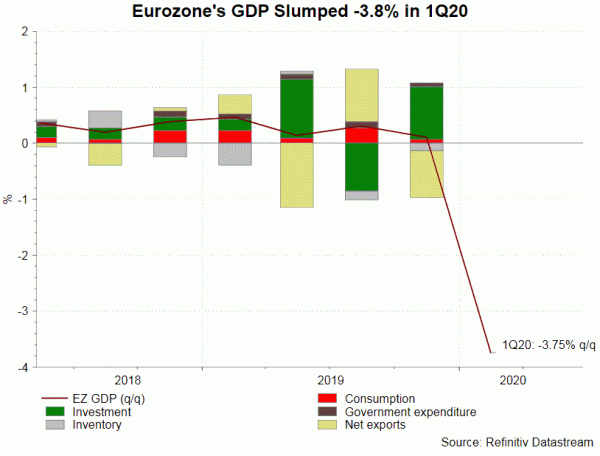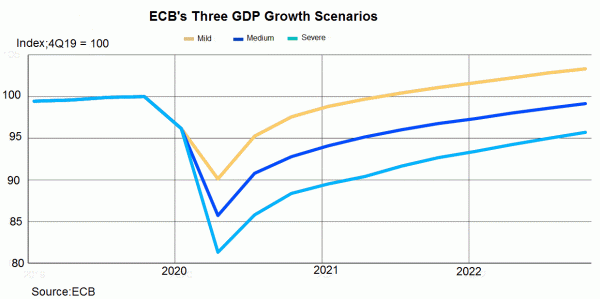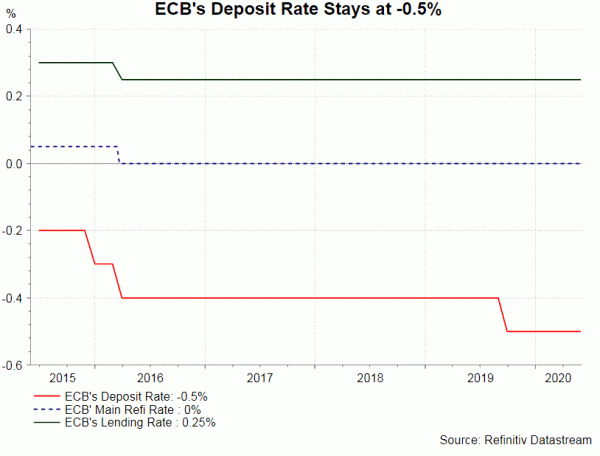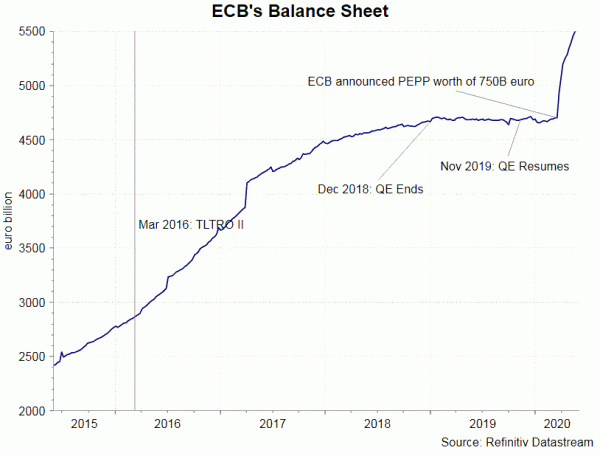We expect ECB to add more stimuli and downgrade it macroeconomic projections at the upcoming meeting. It is likely that the more flexible PEPP will be expanded and extended. Previous meetings suggest that the members are reluctant to lower the deposit rate further. The concerns are mainly the limited impact on the economy and the damage to profitability in the banking industry. Any rate adjustment would probably be done through lowering the rates on TLTROs. On the updated macroeconomic projections, we should see sharp downgrades on GDP growth and inflation. GDP contraction for this year is expected to lie between the medium and severe scenarios presented in May.
PEPP Expansion
The Pandemic Emergency Asset Purchase (PEPP) has been the major instrument adopted by ECB in response to the coronavirus outbreak. On March 18, the central bank announced the program, pledging to buy assets worth of 750B euro until the end of the year. Since the program’s commencement in April, ECB has already purchased about 235B euro, or about one-third, of the designated size. If the pace continues, the program will be exhausted by September this year. In order to keep the program running, we expect ECB to expand the purchase by 500B euro. Depending on ECB’s judgment on the recovery path, it could also announce plans to reinvest assets purchases and/ or extend the program to 2021. These could be announced this month, or in July.
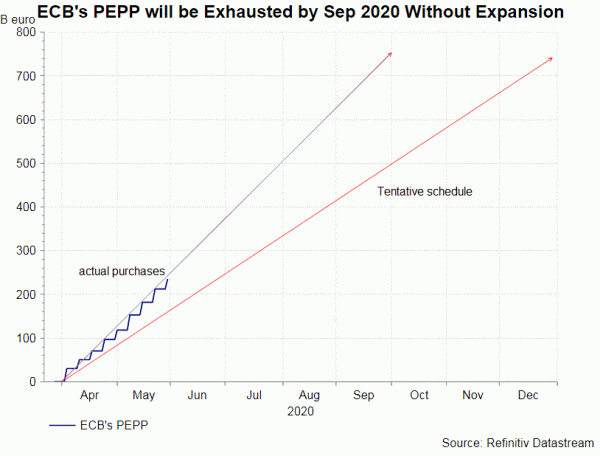 Comparing with the public sector purchase program (PSPP), a program under the umbrella of the asset purchase program (APP) restarted in November 2019, PEPP has greater flexibility. All asset categories eligible under the APP are also eligible under PEPP. Moreover, a waiver of the eligibility requirements will be granted for securities issued by the Greek Government. Non-financial commercial paper is now eligible for purchases both under the PEPP and the corporate sector purchase program (CSPP).
Comparing with the public sector purchase program (PSPP), a program under the umbrella of the asset purchase program (APP) restarted in November 2019, PEPP has greater flexibility. All asset categories eligible under the APP are also eligible under PEPP. Moreover, a waiver of the eligibility requirements will be granted for securities issued by the Greek Government. Non-financial commercial paper is now eligible for purchases both under the PEPP and the corporate sector purchase program (CSPP).
Last month’s German Constitutional Court ruling might also affect ECB’s policy stance. The ruling stated that ECB’s PSPP was unconstitutional in Germany as the central bank had failed to demonstrate that its use was proportional in achieving the mandate. If proportionality is not proved within three months, the Bundesbank would no longer be able to participate in QE. As President Christine Lagarde noted on May 18, the PEPP is not affected by the judgment. PEPP is also less controversial as it is positioned as a temporary tool “that will be terminated when the crisis phase is over”.
Macroeconomic Projections
Under normal circumstances, June is one of the four months that ECB will deliver the updated macroeconomic projections. Economic data flow released since the last meeting shows sharp deterioration in the economy, resulting from the lockdowns and other restrictive measures. Flash GDP shrank -3.8% q/q in 1Q20, compared with a mild +0.1% increase in the prior quarter. The sharpest contraction on record was driven by the lockdown in March as a result of coronavirus outbreak. Deeper economic contraction, however, is expected in 2Q20. As the lockdowns were spread from Italy to other member states including Germany, France and Spain, the full effect of the restrictive measures was felt in April and May.
In April, headline HICP eased to +0.3% y/y, from +0.4% a month ago. Core inflation steadied at +1.1%. Flash inflation slowed further to +0.1% in May, while core inflation stabilized at +1.1%. On the job market, the unemployment rate increased further to 8.2% in April, from 7.4% previously. Weakness in the job market and fragile consumer confidence were reflected on consumption. Retail sales dived -22.3% y/y in April, after a -9.2% fall a month ago.
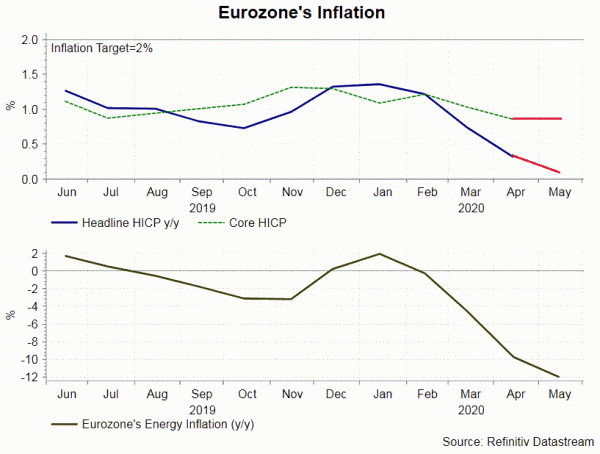 While incoming data suggest that the worst is behind us. Some sentiment indices have sent a mixed message. The economy appears on gradual recovery in May. Final Eurozone Manufacturing PMI improved +5 points to 39.4 in May. As noted in the accompanying report, “the manufacturing downturn looks to have bottomed-out in April, with production falling at a markedly slower rate in May”. The report added that the improvement was resulted from a “comparison against a shockingly steep fall in April, but more encouragingly was also linked to companies restarting work as virus lockdowns were eased. Developments of the pandemic in coming months are the key as it affects whether (and to what extent) the restrictions can be lifted. On market sentiment, Business climate index worsened to -2.43 in May, from a downwardly revised -1.99 in the prior month. Economic sentiment slipped to 67.5 from April’s 64.9. Services sentiment dropped -5 points to -43.6, while industrial sentiment improved +5 points to -27.5.
While incoming data suggest that the worst is behind us. Some sentiment indices have sent a mixed message. The economy appears on gradual recovery in May. Final Eurozone Manufacturing PMI improved +5 points to 39.4 in May. As noted in the accompanying report, “the manufacturing downturn looks to have bottomed-out in April, with production falling at a markedly slower rate in May”. The report added that the improvement was resulted from a “comparison against a shockingly steep fall in April, but more encouragingly was also linked to companies restarting work as virus lockdowns were eased. Developments of the pandemic in coming months are the key as it affects whether (and to what extent) the restrictions can be lifted. On market sentiment, Business climate index worsened to -2.43 in May, from a downwardly revised -1.99 in the prior month. Economic sentiment slipped to 67.5 from April’s 64.9. Services sentiment dropped -5 points to -43.6, while industrial sentiment improved +5 points to -27.5.
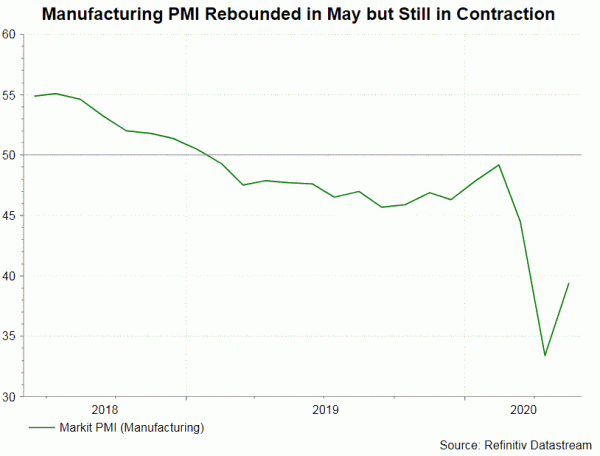 On May 1, ECB presented three scenarios for GDP growth: 1) a mild one (5% drop in GDP this year, 6% rise in 2021); 2) a medium one (8% drop followed by 5% recovery); and 3) a severe one (12% contraction followed by 4% rise in 2021). president Lagarde suggested last week that “the mild scenario is out of date” and “it’s very likely that we are somewhere between the medium and severe scenarios”. We therefore expect that ECB’s GDP growth projection would lie between 8-12% contraction for 2020. The scenarios did not include inflation projections. With inflation targeting as the major objective, ECB’s inflation forecasts will be closely watched. Although inflation in April and May were largely steadied, both actual readings and market expectations are far below the 2% target. These suggest that ECB will downgrade sharply its inflation forecasts in January (which is totally outdated by now) and that further stimulus measures are warranted.
On May 1, ECB presented three scenarios for GDP growth: 1) a mild one (5% drop in GDP this year, 6% rise in 2021); 2) a medium one (8% drop followed by 5% recovery); and 3) a severe one (12% contraction followed by 4% rise in 2021). president Lagarde suggested last week that “the mild scenario is out of date” and “it’s very likely that we are somewhere between the medium and severe scenarios”. We therefore expect that ECB’s GDP growth projection would lie between 8-12% contraction for 2020. The scenarios did not include inflation projections. With inflation targeting as the major objective, ECB’s inflation forecasts will be closely watched. Although inflation in April and May were largely steadied, both actual readings and market expectations are far below the 2% target. These suggest that ECB will downgrade sharply its inflation forecasts in January (which is totally outdated by now) and that further stimulus measures are warranted.
ECB’s Conventional and Unconventional Monetary Policy
- Kept deposit rate unchanged at -0.5% (since Sep 2019)
- Pandemic Emergency Purchase Programme (PEPP): asset purchases worth of 750B euro until end -2020 or longer.
- Temporarily increased asset purchase programme (APP) by 120B euro /month until end-2020, especially in corporate bonds
- Launched new LTROs (interest rate at -0.5%) until June 2020 to fund banks’ liquidity needs
- Improved TLTRO-III: banks can borrow at -0.25% and reduce their ex-post borrowing cost to as low as -0.75% if providing credit beyond a certain benchmark
- Launched new PELTRO term facility for banks and further sweetens the terms of its TLTRO-III facility.




